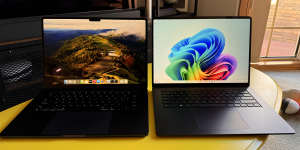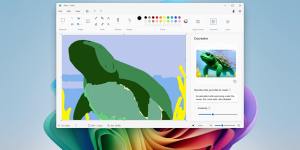It is the company’s first,meaning it’s built for artificial-intelligence tasks and has dedicated processing hardware to facilitate them. It is by far the most powerful and longest-lasting battery Surface laptop yet,beating the M3 Air in both measures while also undercutting it on price. Its screen,port selection and display put many competitors to shame. Yet,many of these improvements come with a caveat.

To provide the power inside its seventh generation laptop,Microsoft has turned to Qualcomm rather than Intel,meaning the machine is running on an ARM-based processor.
The implication for Windows is that few applications will run natively and thus take full advantage of the new hardware. Most apps,designed for Intel chips,run through Microsoft’s emulation layer.
The result is a wonderful Windows laptop with truly astonishing power and battery life – if you stick to the most common tasks and apps. But eventually (or,more likely,immediately) you’ll run into a program that needs to be emulated,and from there your mileage may vary.
Surface level sheen
Something that hasn’t changed is the Surface’s place among the nicest Windows laptops. Coming in either a 13-inch or 15-inch size,the new device looks and feels extremely classy,from the thin bezels on the display to the smooth metal of the palm rests.
The Surface features Microsoft’s characteristically tactile keyboard returns (with an extra key for AI,more on that later). And in addition to the proprietary charging port,there are two USB-Cs and a USB-A and a microSD – an upgrade from prior less generous devices.
Above the display sits a surprisingly good 1080p webcam that doubles as a face scanner for logging in and verifying your identity,which I found very snappy,and the screen itself is a bright and sharp 120Hz Dolby Vision touchscreen LCD.

The Surface Laptop (right) is similar physically to the M3 MacBook Air (left),but has the technological edge.Tim Biggs
Much has been made (by Microsoft) of the device’s battery life,with the spec sheet quoting up to 22 hours of video playback,versus 18 hours on Apple’s latest MacBook Air. While I haven’t left a video on loop to test that,it’s clear the Surface is an endurance beast.
After a full eight-hour work day on battery,it’s typically sitting above 60 per cent. It barely uses battery at all in sleep mode,and even when I was pushing it hard (downloading and testing graphic-intensive apps),it ran for more than six hours before I received a 20 per cent battery warning,which is wild for a Windows laptop.
The Surface also stands up well against the MacBook when it comes to price and specs. The entry $1900 model has 16GB of RAM and a 256GB SSD,whereas the M3 MacBook Air,with a similar sized screen,is $1800 but only had 8GB of RAM. Bumping the Mac to 16GB takes the price to $2100.
AI for the future,but not much now
The new Surface is one of the first Copilot+ PCs,meaning it meets Microsoft’s requirements to run special AI-augmented applications. This is a big deal in theory because the powerful neural processing unit (NPU) in the device,paired with a secure connection to AI cloud servers,could make for much more effective and efficient use of generative models than on other laptops. However,in reality,these first devices don’t put their best foot forward.

Microsoft’s Cocreator works to turn a very carefully-made blob into AI art,but that’s all it does.Supplied
The marquee Windows feature for Copilot+ PCs was set to be Recall,which ironically given the name has been pulled out of the software owing to security concerns. Microsoft says the feature,which lets you search your PC’s history by asking about things you’ve done previously,will arrive at some point in the future. The rest of the Windows AI features are interesting,but not compelling.
In Paint,a new Cocreator option lets you write a prompt for the image you want,then as you draw it,an AI interprets your strokes into a painting. Almost all results are frankly unusable for any project I could think of. The only way to get it to follow your lead is to use big blocks of colour to indicate where you might like objects to go — the system has no idea how to interpret things such as stick figures or line drawings.
In Photos,you can quickly generate images using any prompt,which is impressive but familiar. Like the Cocreator,this is using local models rather than cloud-based,but you still need to be connected to the internet for quality control purposes.

Recall was touted as a new way to search through your files and experiences on PCs,but it’s been delayed.Supplied
One impressive AI feature is the new Live Captions,which works at a system level to show captions for any audio passing through Windows (and potentially translating from other languages),including video files or Zoom meetings,or even audio picked up from the microphone. This uses local AI models,so it even works when you’re offline and the results are excellent,with the usual caveat that it works best with clear and slow speech.
As for the new Copilot button on the keyboard,all it does is open the desktop Copilot app,which isn’t always the most useful. If you are using an app that has a specific Copilot integration,you might expect the Copilot key to activate that (for example,to trigger a web page summary in Microsoft Edge),but it doesn’t. Copilot is an impressive chatbot,but using it here isn’t markedly different from using it in a web browser on any PC.
The real advantage of the NPU is its ability to process generative tasks quickly and efficiently without taxing the CPU or GPU. Using Photoshop or the local stable diffusion models with the Task Manager open,I can see the tasks are barely troubling the CPU,which points to a future of fast and on-demand AI tasks. But right now,that won’t benefit too many users.
Windows-on-ARM is great,not perfect
Running apps on the new Surface adds an extra layer of complexity,albeit largely invisibly.
Any apps with a native ARM-based version are snappy,and provide exactly what you’d expect from a new laptop. Any time you run an app that isn’t built for ARM,Windows uses a tool called Prism as a kind of translator. This means you’ll burn more battery while using these apps and performance is not as high. In the worst case,you might find apps that don’t work at all.
So,what does this all mean in practice? If you stick to browsers and the most common apps,you might not notice at all. If you rely on some arcane USB accessory that needs special software that will not be updated,you will have cause to worry. Most of us will be somewhere in between.
I found the ARM versions of Chrome and Edge performed well. Microsoft is also proud of its side-by-side comparisons,showing ARM-based Photoshop churning through twice as many renders per minute on Surface compared with MacBook – and it really does work that way. I also found ARM-based versions of Spotify,VLC,7-zip and GIMP. Other Adobe apps will launch in ARM soon.
Through Prism,simple file converters and patching apps I use all the time worked fine,and slightly more complex apps such as Audacity and Plex went off without a hitch. I had issues with Discord running quite sluggishly,and randomly emulated apps would seem to lag on the UI elements. But in almost all cases,emulated apps were acceptable.
On the other hand,there are some total non-starters when it comes to Prism. For example,my VPN app of choice simply refused to start,and this seems to be a problem with VPNs and Prism in general. The Google Drive desktop app also failed,and some prominent resource-intensive apps (such as video editors) will tell you the PC doesn’t meet its requirements.
Video games are also an aspect where you can expect friction. There are hardly any games for Windows with ARM-based builds,and many online games will not work at all through Prism. Most games in the Microsoft Store are unavailable due to incompatibility,and I had mixed results playing games through Steam;indies and older big-budget games generally ran well,while recent games were far less stable than you would expect on a new Windows laptop.
Prism will,of course,improve over time,and the NPU could be implemented to do things such as boost game frame rates using temporal upscaling. But combined with the early AI experience,compatibility with Intel-based apps is a question mark that means most users will be better off waiting to see how the new Surface pans out before they jump in.
Get news and reviews on technology,gadgets and gaming in our Technology newsletter every Friday.